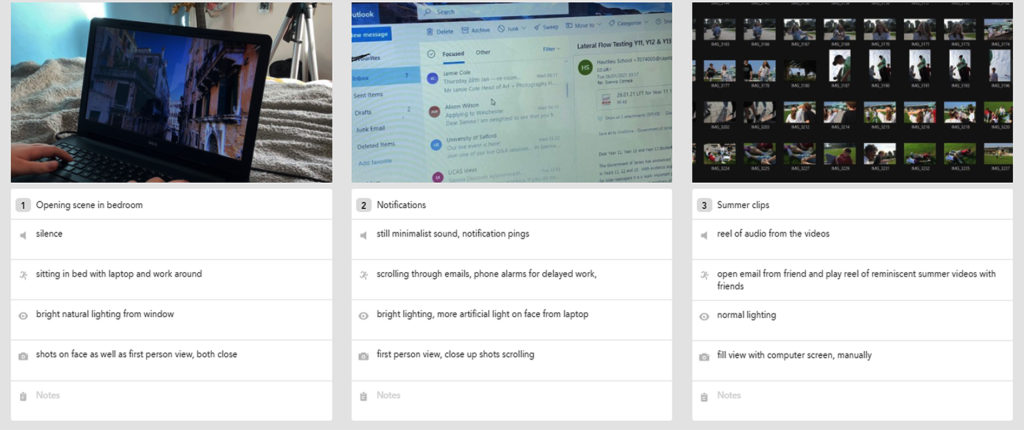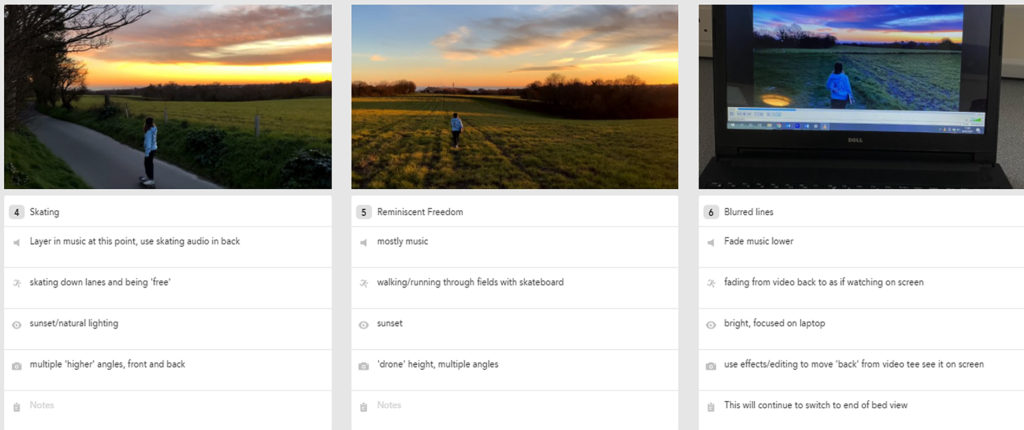Water

Person
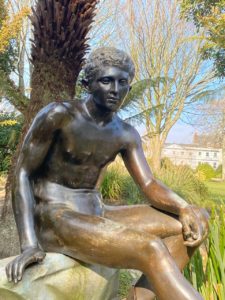
Circle
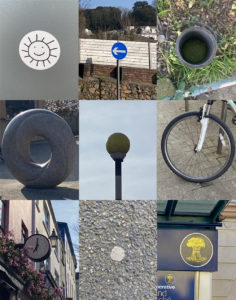
Shoe
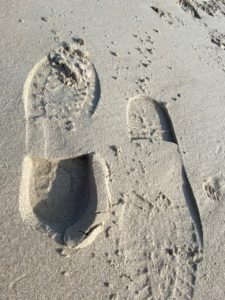
Sea
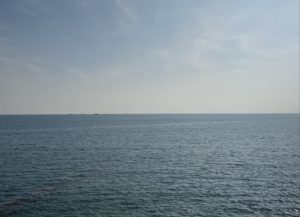
Tree
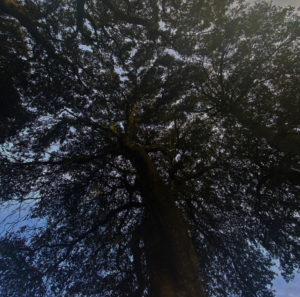
Cliff
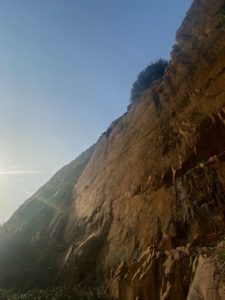
Nature
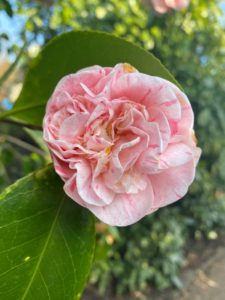
Sun

Mirror
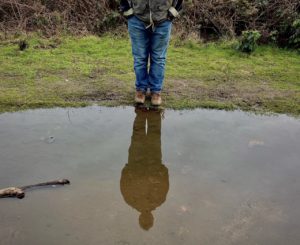
Water

Person

Circle

Shoe

Sea

Tree

Cliff

Nature

Sun

Mirror


Initial ideas: I created this film to visualise the teenage experience of many during recent isolation and pandemic situations, contrasting the difficulties of online learning in isolation with the freedom of summer and missing times with friends. It became a great creative outlet for me just producing a product that really highlighted how the last year has felt , but i am also happy with my final film from its technical aspects. My first ideas came from a few different amateur student films i had found online about quarantine experiences such as ‘Numb’ by Liv McNeil and ‘Quarantine Perspective’ by Myles Dean. From these i chose a few specific camera shots i wanted to reflect in my footage, as well as the time-lapse idea from ‘Numb’. Through the initial ideas i developed them during the editing process to add my own style, deciding to create the isolation time-lapse, but layering it over chosen videos from summer to show the extreme contrasts in a single shot sequence – which overall i think created a really impactful ending to my film.
Filming: Overall i thoroughly enjoyed the filming process for my project. My film was split into three different sections, where before each shoot i had fully planned each individual shot to make the filming process easier and precise. The first section is all based in my bedroom, focusing on the struggles of online learning. I kept this section basic, using simple shots and minimal audio as i wanted it to allow the space for a build up throughout the rest of the film, and slowly introduce the main themes of the film. I used a quick and simple time-lapse sequence to show the unproductive passing of time felt during quarantine which would then link to the dramatic ending sequence in the film, and introduced a few short archived videos from summer to initially show the feelings of missing times of freedom. The second section was the most enjoyable and fun to film. I was very lucky when it came to the day of filming, catching a beautiful sunset which made all of the shots look stunning naturally. I had a friend help film this, using a high tech stabiliser for a phone, directing them through what angles i was looking for, and discovered that if you held the stabiliser up high, it created an aerial, drone looking point of view which i thought was a really unique angle (inspired by shots from Myles Deans short film). I combined different shots of me walking through fields with a few skating shots for some diversity, switching between third and first person perspectives, with the overall aim to create a general visualisation of ‘freedom’. The final section of my film was about creating a lasting, impactful message that encapsulated my whole idea of contrasting the stagnation of isolation to the feelings of freedom and missing the fun times during summer. At first i was planning on filming each section of the time-lapse everyday after a few weeks and filming later in each day to capture the slow decline with light, but instead realised it would be much easier to film it all at once, ensuring my tripod wouldn’t be knocked out of place and the composition of the camera would be the exact same. So between each shot i changed clothes, moved a few objects around my bed, and once i was halfway through, used my blinds to slowly control how dark the scene looked. This allowed the editing process to be much easier and i could choose which background archived videos would match up with the footages lighting.
Editing: The editing process for this film was quite long as i had many specific sequences and transitions i wanted to include, as well as a very clear idea of the way i wanted the film to flow throughout. I have multiple blog posts on the detailed editing process of the three sections, but there were some key points i think came out well. With the filming process as well, i knew i wanted to have certain footage that would act as transitions themselves and lead into the next scene, so i made sure especially between the field and time-lapse section, i had a a separate clip of me physically leaning into the time-lapse to clearly link those parts well. I made a fair few changes from my idea of the time-lapse to the final product when editing, as once i started i saw lots of areas for improvement. I changed the length of each clip from one second to just less than half a second as found the sequence to be too short, and then actually used the other half of it and added it somewhere else to make the time-lapse longer to have time to fit in more archived videos. Last minute i also decided to edit the time-lapse video to grow every few clips to take over the screen until at the end it had fully covered over the background videos, which i thought added some dramatism to the sequence. This grew with the background music, which i had slowly brought in during the second sequence, however edited the audio of all the field and background videos during the time-lapse to varying levels so it seemed as though the dramatic music grew even more throughout the film than it originally had. I also used lots of gradual and continuous fade transitions throughout the film, mostly to transition between archived videos. I was most proud of one gradual fade that i used at the end of the freedom section, to switch from ‘live’ filming of the field to the video playing on a laptop screen and slowly moving back to a wider view. I think this turned out really well and was effective in creating a hybrid of both the main themes in one shot.
Final thoughts: Overall i felt my short film was successful and i am very happy with how it turned out. I think this project really helped develop my technical skills needed for editing on Adobe Premier Pro, as well as structuring a short film in an effective way to tell a narrative. After uploading my film to YouTube i received lots of positive feedback from viewers, with the video now having over a hundred views, which i think really helped solidify my confidence in the outcome of this project. The inclusion of different filming styles such as the time-lapse sequence and experimenting with different filming technology for the drone-like footage allowed me to explore styles i don’t normally use and i think brought a unique aspect to my film. If i were to change anything about my project i think i would expand my research of a few more artists and bring in their styles to my own, to help experiment with a few more underlying themes and develop my narrative skills. To conclude, i’m very happy with the outcome of this project and put in a lot of effort to try and reflect the shared experiences of the past year in a way that allows many people to identify with, as well as express my own perspective in a rewarding and creative way.
How has snapshot photography developed from its origin in Victorian times to our digital age?
Essay Plan+
Opening quote:“I am a passionate lover of the snapshot, because of all photographic images it comes closest to truth […] The snapshooter’s […] pictures have an apparent disorder and imperfection, which is exactly their appeal and their style. The picture isn’t straight. It isn’t done well. It isn’t composed. It isn’t thought out. And out of this imbalance, and out of this not knowing, and out of this real innocence toward the medium comes an enormous vitality and expression of life.” —Lisette Model
Introduction: Introduce subject of essay Explain why interest came from, begun from student films for my own film.
Intro (First page of Say Cheese) – The term snapshot as a photographic medium has only been around for a century. The term defines something that is captured instantaneously, typically captured by an amateur and often candid and imperfect. However through time this idea has developed from formally staged and stiffly structured images in the Victorian era, with a long image develop time; all the way to its modern uses, expressed both artistically and mundane due to is easy accessibility through technological developments. i have chosen this topic because i have been look
Pg 1: historical context
Discuss origin of snapshot aesthetic in Victorian times alongside technological invention of camera technology / Kodak box camera etc. Also comment on photography becoming more affordable for professional/ middle classes. Read key text and select appropriate quotes
Select a key image from Victorian period and analyse in more depth, in terms of its subject-matter, technical aspects, composition and interpret how this image may comment on the economic growth and prosperity of the middle classes who could afford to buy a camera and begin to depict their own lives. Photograph themselves on holiday, enjoyment in leisure time showed modernity, time off work and changes in society – building photography in modern form
Pg 2: How snapshot became an aesthetic style – art. Discuss how photographers such as Nan Goldin adopted the snapshot aesthetic in her work – the sexual dependency book. What the aesthetic is and its meaning, the look, following an amateur approach. Analyse image from the book, same aspects as earlier. Look at interviews from her and quotes.
Pg3: Digital age of snapshot aesthetic, accessibility of camera (mobile phones) and share easily online, with subject matter changing to more everyday, uneventful things. Link back to change in earlier era.
Conclusion:
vernacular photography – snapshot style, amateur footage
old camera snapshot, modern mobile phone snapshot , current photographer aesthetic, snapshot aesthetic can be adopted by prof artists
How does vernacular photography, supported by the mainstream production of kodak, present an idealised perspective on moments – draft question
How is vernacular photography, supported by the mainstream production of kodak, an overlooked artistic style – draft question
How has snapshot photography developed from its origin in Victorian times to our digital age?
references: student films, numb by liv mcneil, sadie withers pd11, erik kessels, nan goldin – mark in the red car, cookie w max in hammock, dieten and wolfgang at the O bar, nan and brian in bed,
photographers snapshot aesthetic
Women photographers and the ‘snapshot aesthetic’7
intro what why how
Essay Plan+
Opening quote:“I am a passionate lover of the snapshot, because of all photographic images it comes closest to truth […] The snapshooter’s […] pictures have an apparent disorder and imperfection, which is exactly their appeal and their style. The picture isn’t straight. It isn’t done well. It isn’t composed. It isn’t thought out. And out of this imbalance, and out of this not knowing, and out of this real innocence toward the medium comes an enormous vitality and expression of life.” —Lisette Model
Introduction: Introduce subject of essay Explain why interest came from, begun from student films for my own film
Pg 1: historical context
Discuss origin of snapshot aesthetic in Victorian times alongside technological invention of camera technology / Kodak box camera etc. Also comment on photography becoming more affordable for professional/ middle classes. Read key text and select appropriate quotes
Select a key image from Victorian period and analyse in more depth, in terms of its subject-matter, technical aspects, composition and interpret how this image may comment on the economic growth and prosperity of the middle classes who could afford to buy a camera and begin to depict their own lives. Photograph themselves on holiday, enjoyment in leisure time showed modernity, time off work and changes in society – building photography in modern form
Pg 2: How snapshot became an aesthetic style – art. Discuss how photographers such as Nan Goldin adopted the snapshot aesthetic in her work – the sexual dependency book. What the aesthetic is and its meaning, the look, following an amateur approach. Analyse image from the book, same aspects as earlier. Look at interviews from her and quotes.
Pg3: Digital age of snapshot aesthetic, accessibility of camera (mobile phones) and share easily online, with subject matter changing to more everyday, uneventful things. Link back to change in earlier era.
Conclusion:

To start with my time-lapse, i imported all the individual videos, rendered them and began cutting them down to one second increments each, with all the audios unlinked and removed
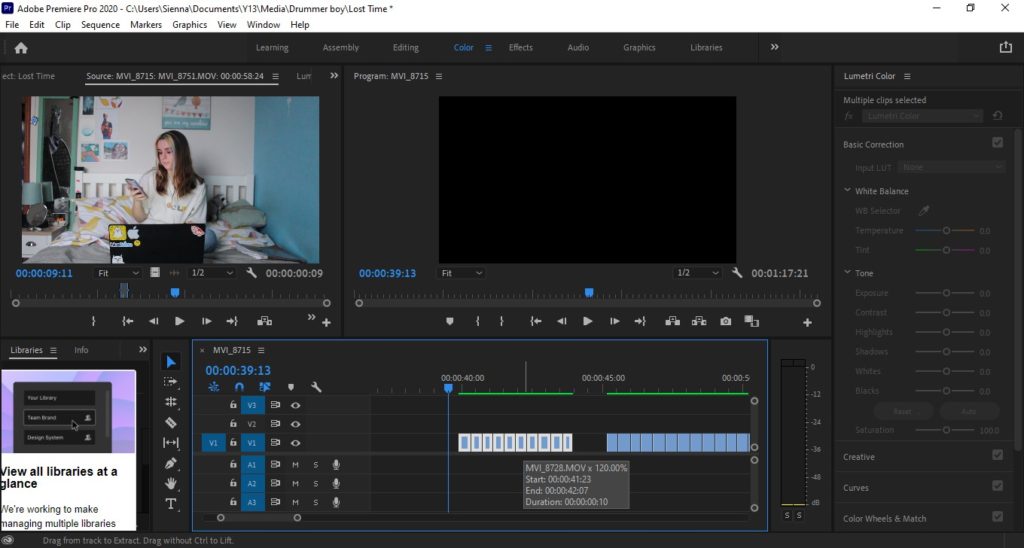
I then cut them all down to half a second as i thought the quicker pace fit better, and used the other half of clips to insert in other places just so i had a bit more footage to lengthen it. i also made sure to cut the moving clips, i used three events with around 5 clips for each, one leaning over to pick up and look at my phone and another towards the laptop, and the then at the end slowly covering my face
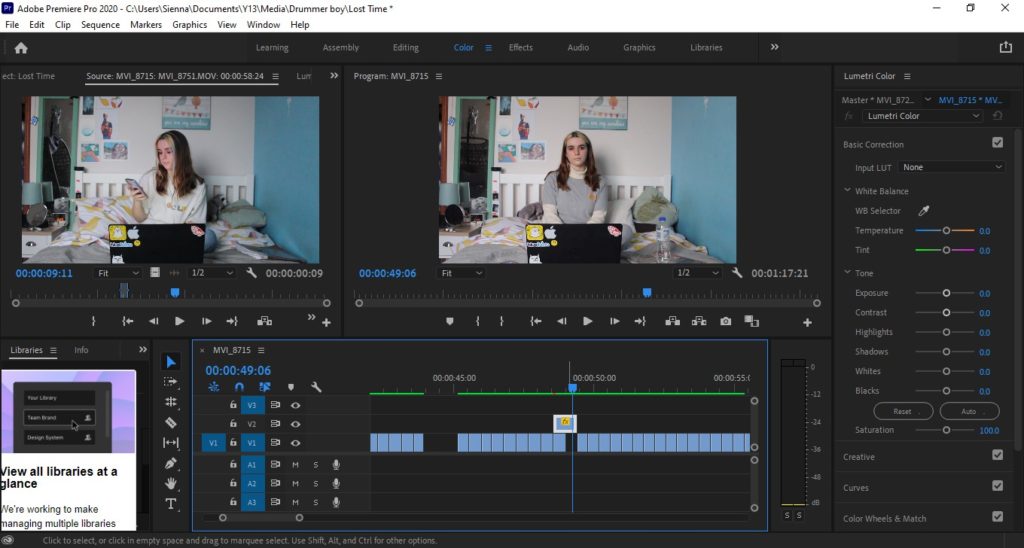
I then finished cutting them all and sequenced them together, rendering often, and made sure they were all the same length to keep the pace, except from the last clips in the leaning forward movement, slowly extending them to slow down the pace

I then saved the initial time-lapse (just the bare sequence) and imported it to another project page. I then imported a selection of archived videos i had taken in the summer, and layered these above the time-lapse sequence. These were cut to appropriate lengths, keeping their original sound, and sequenced and rendered behind the time-lapse video. I then minimised the time-lapse video to be smaller in the centre of the frame.

Once layering the archived videos in the background, i thought the time-lapse speed didn’t match up right and was not quick enough, so i set the speed duration to higher so that i could easily decrease the duration each scene was shown – with the background videos at their normal speed.
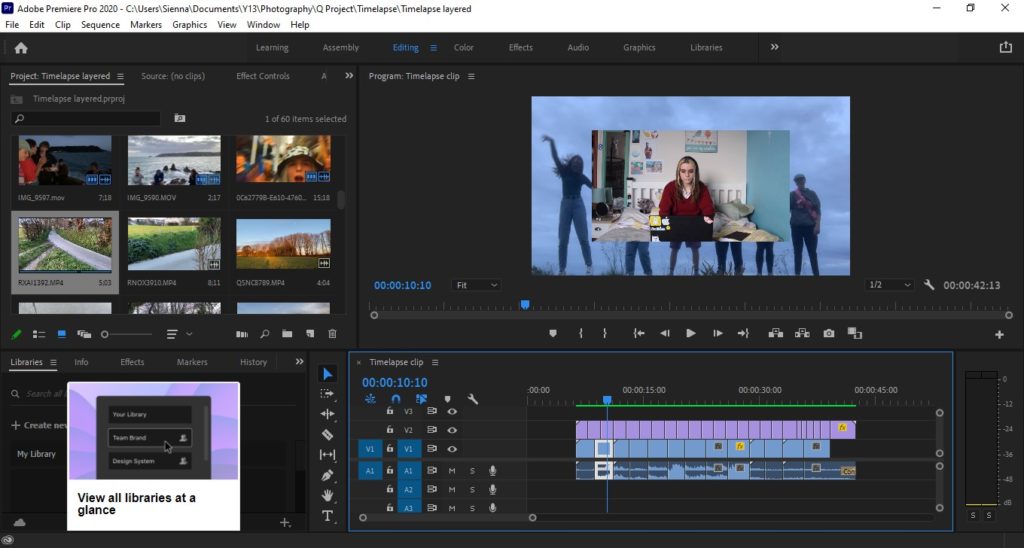
I then began cutting the smaller centre video every few seconds and enlarging it slightly so that as the video got darker, it enlarged over the screen, until eventually it covered the whole screen in its end scene, which i began to enlarge more frequently in the last slower movements.
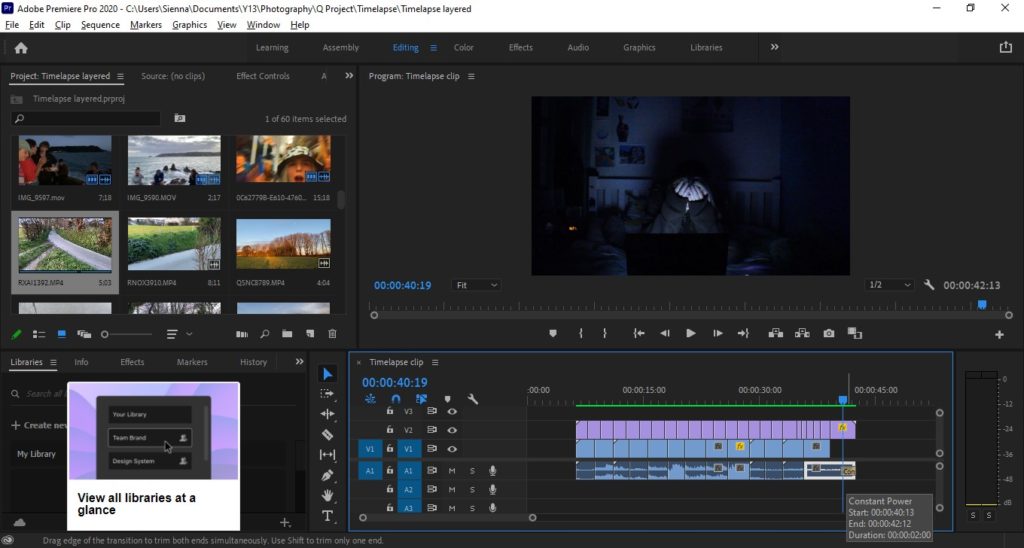
With the last much longer scene, i extended the last archived videos audio, which has the sound of wind and waves, and pulled it to cover over the whole last clip.
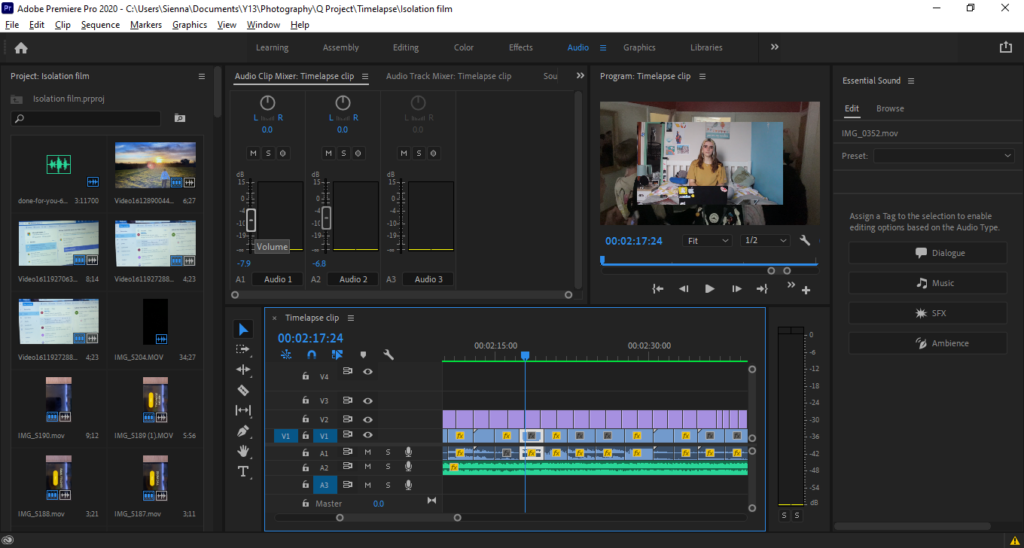
I then added the background music to run underneath the whole sequence, and went back over each archived videos audio and reduced them so that they weren’t overpowering the music.
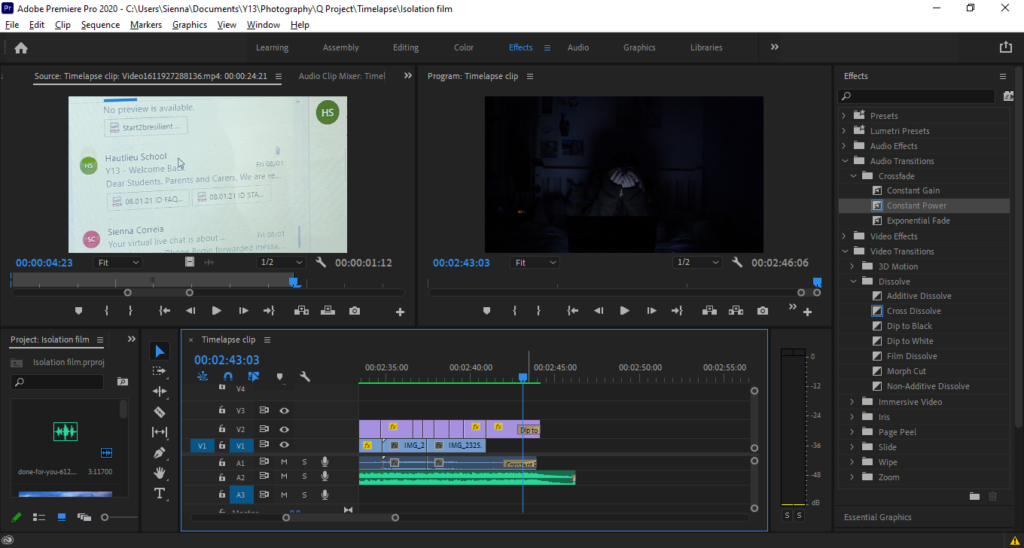
Finally i added a fading transition to the video and background audio clip, extending the audio to end after the video footage
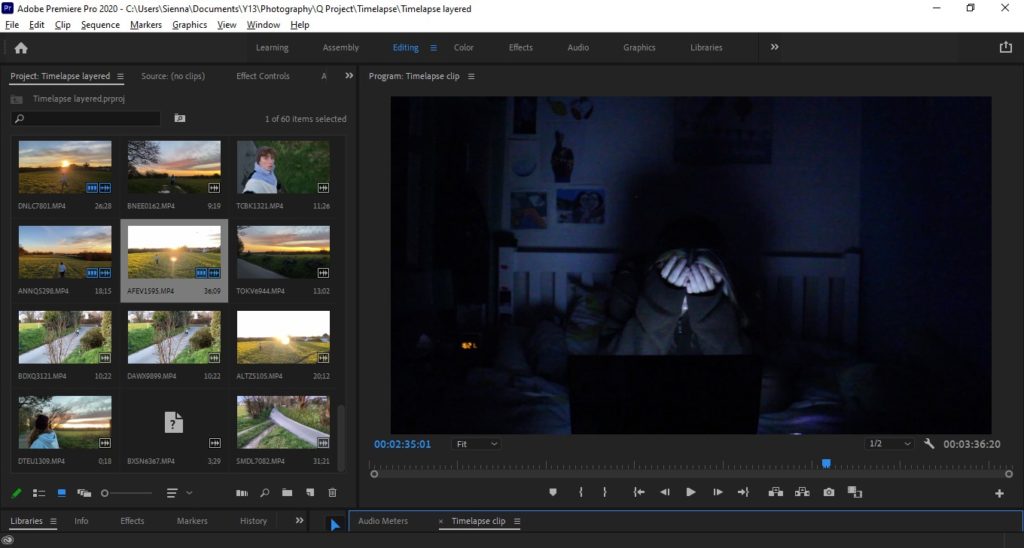
First i uploaded the album of all the videos from this shoot into the side bar as there were all large 4k files
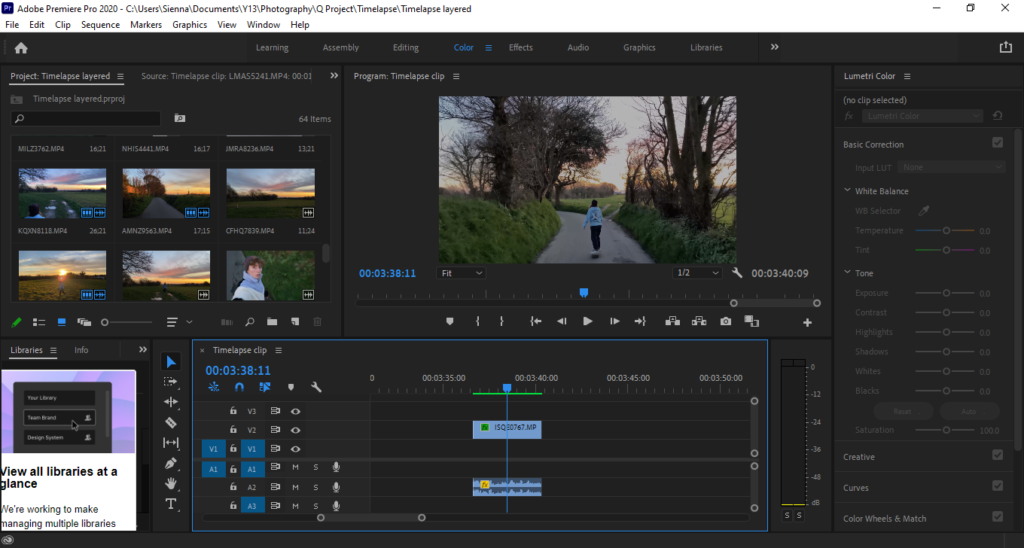
Once all the videos were imported, i had a lot of footage and checked over which i wanted to include. With one clip it was very shaky so i applied a warp stabilizer affect and rendered the video, making it much smoother, and cut it to a shorter length.
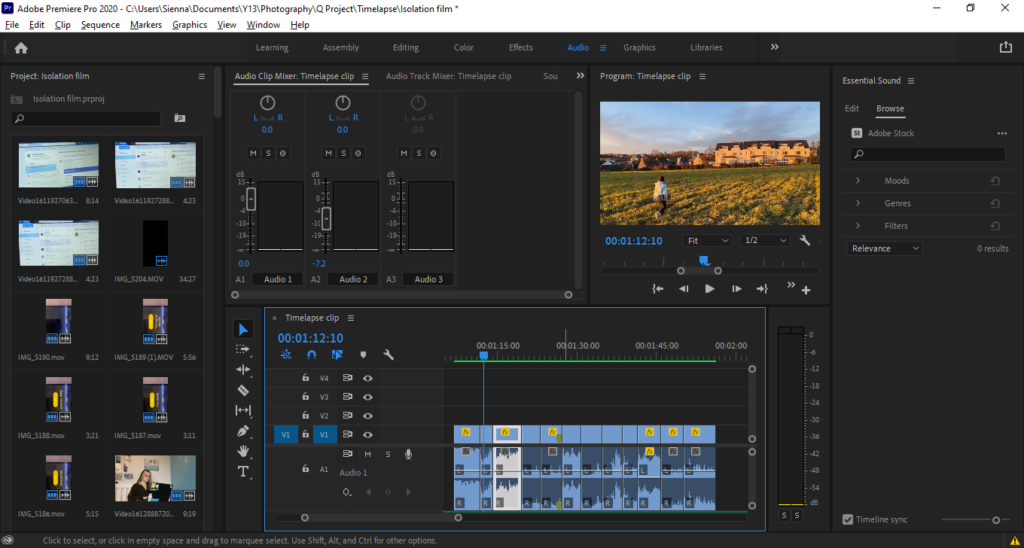
Next i cut all the clips simply together, mixing between ‘drone’ and skating footage, and adjusted all the audio to have some of the natural sounds, but more mellow as there’s also going to be an overlay of building music in the background
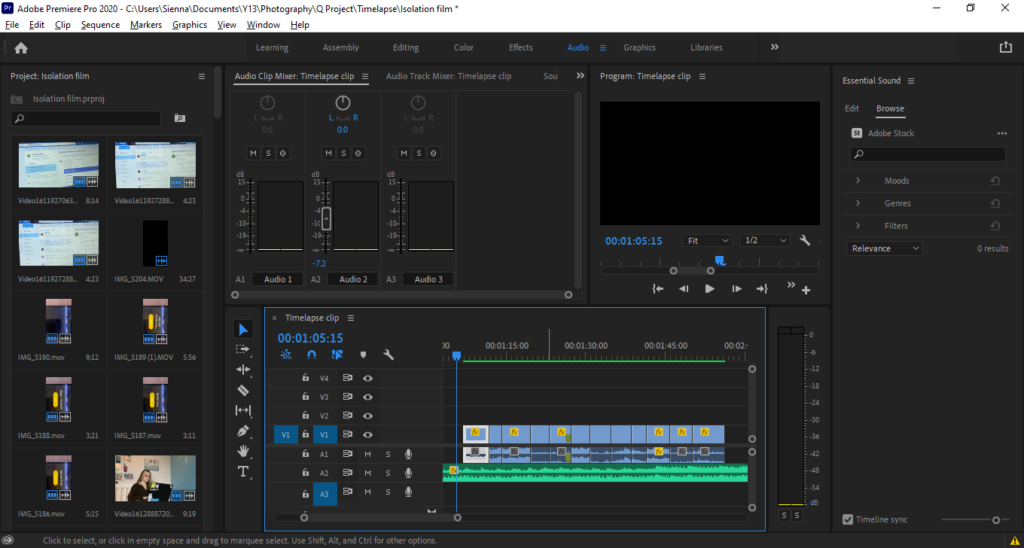
I then imported the audio, which runs through all the field clips, and altered the volume, which will fade in and out from the before and after clips.
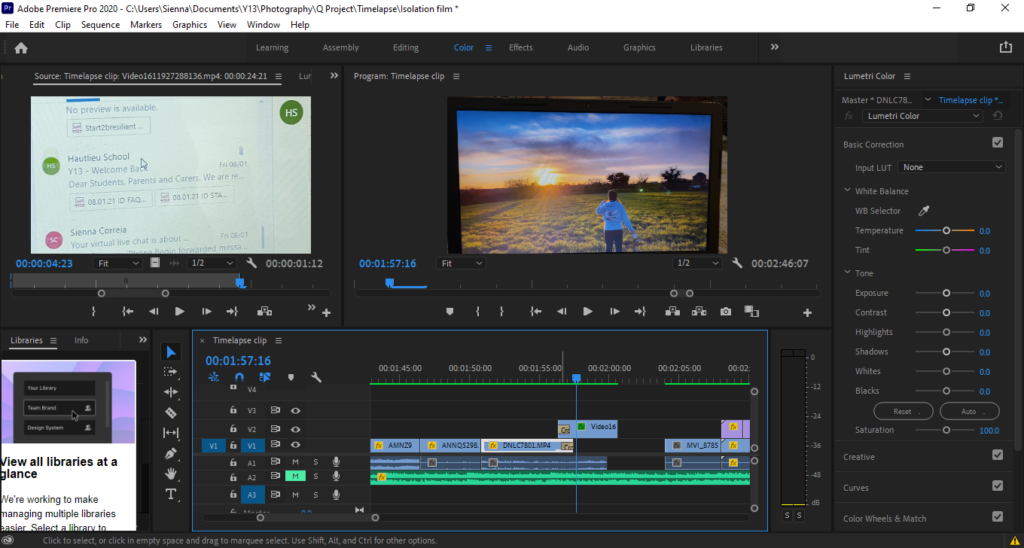
Lastly used cross dissolve on two clips to create a fading transition from ‘live’ filming to it appearing on a screen, and ran the live audio through
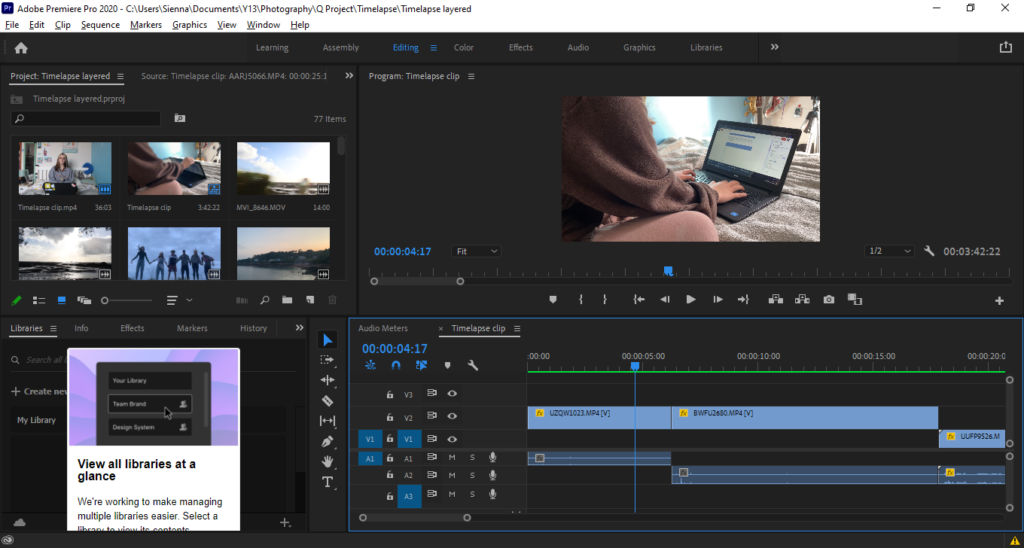
Firstly I uploaded all the footage for this scene and lay them out roughly – resizing, cutting appropriate frames and rendering all videos.

I then had lots of short videos of phone alarms, so cut these together with the first transitional frame being slightly longer, and the rest following a quick paced time-lapse style sequence.
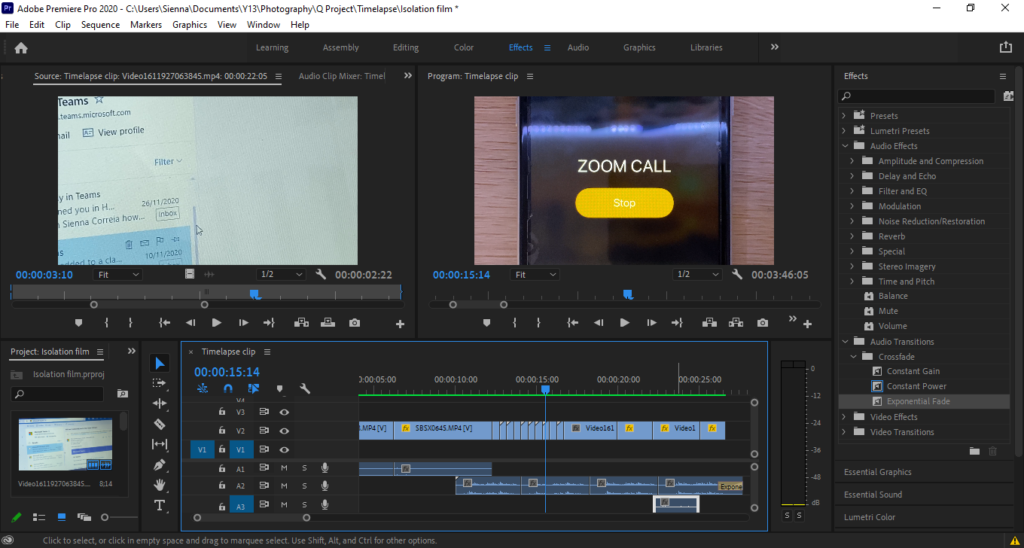
I then layered a continuous audio of the phone alarm across these short clips, as well as before (to transition into the sequence) and after to show a continuation. I then used an exponential fade to slowly blend out the alarm.
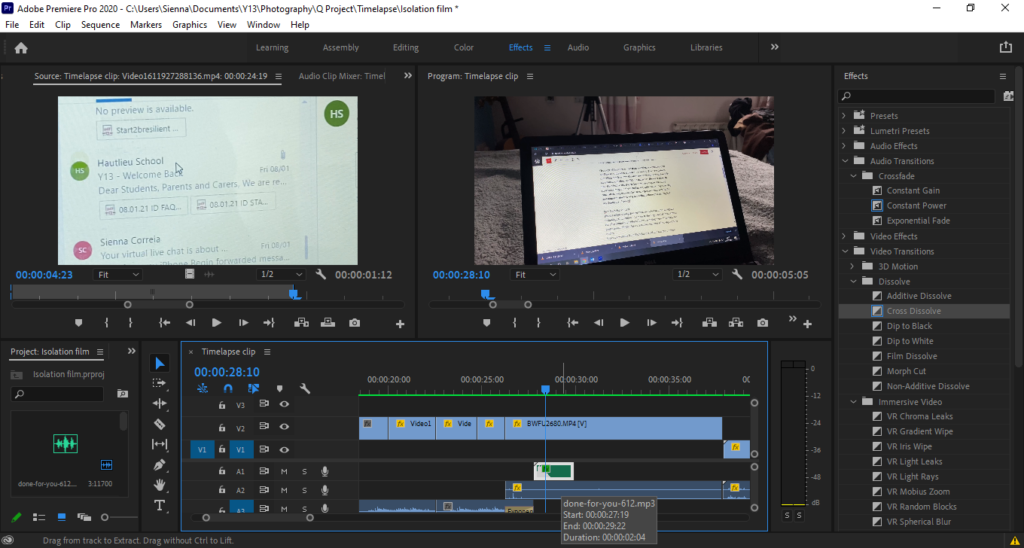
I then found and imported an email notification sound effect, and layered it an appropriate time with the video.

With the archived summer videos, i had them playing on the screen and used transitional fades to layer and switch between the multiple videos
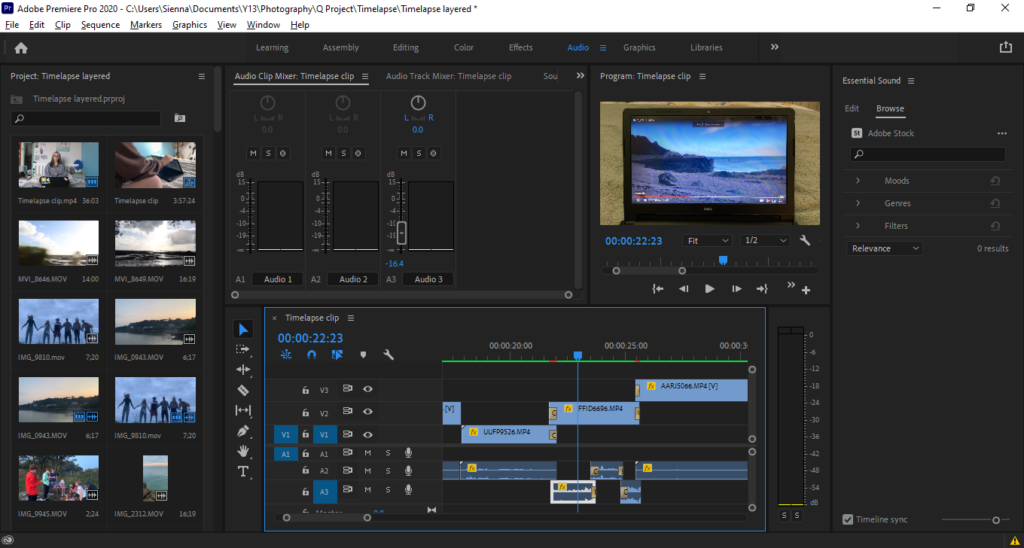
Next i imported the audio from the original videos, and used these to layer in sequence with the videos on the screen (removing the videos own audio). I adjusted these to a lower volume and used continual fade transitions to continue through one video to the next. For one clip specifically i cut up and re adjusted the audio as it had a flaw (loud shout in the background i didn’t want to include) and used fades between the cut audio to have them smooth, and make it unnoticeable that the audio had been edited.
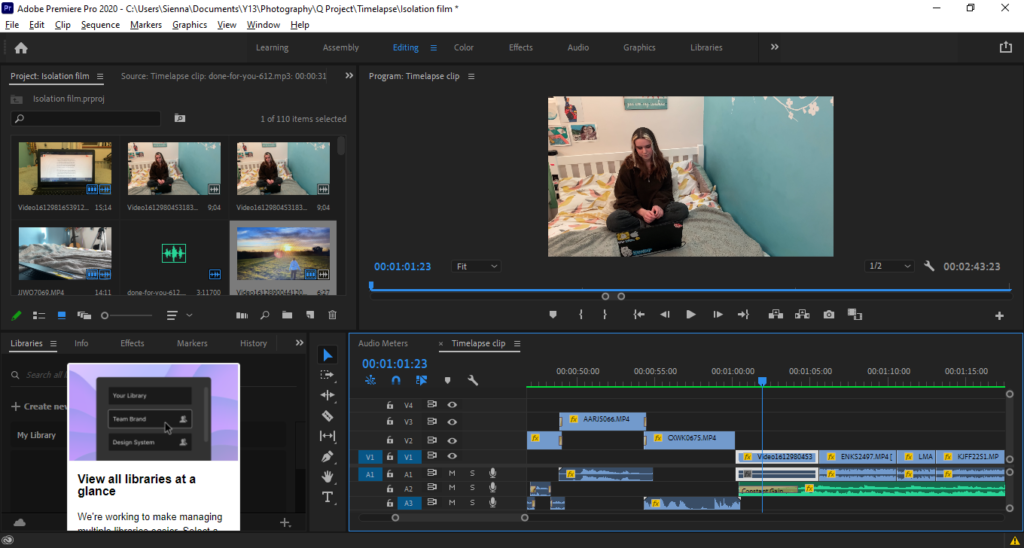
Lastly i continued the last videos audio slightly into the next clip, and used a constant gain transition at the beginning of the shown transitional to bring in and set up the music for the next scene
